- Sugarbaby Watermelon Guide 101: Growing, Care, and More - July 21, 2022
- White Sunflower Varieties Guide with Care and Growing Tips - July 16, 2022
- Black Krim Tomato Guide: Growing, Care, and More! - June 28, 2022
I’ve been growing tomatoes for a couple of years now, and at the start of the journey, I could have really used a guide to troubleshoot white spots on my tomato plant. Tomato plants are pretty susceptible to pests and diseases, but simply not meeting the best care requirements for these plants can result in white spots and other issues.
When I first noticed white spots on my tomato plant, I was lost. (Is this you, now?)
I wasn’t sure if it was mold, a fungus or bacterial infection, a viral disease, or something else. My sister, who has a green thumb and is quite knowledgeable about crops, has taken me under her wing. Now I know exactly how to troubleshoot when I see white spots on a tomato.
If you’ve seen white spots on your tomato plant and don’t know what’s up, you’re in the right place. I’m sharing what could be the cause (there’s more than one!) and ways you can get rid of (and prevent!) the white spots.
My Bottom Line Up Front
White spots on tomato plants can result from various bacterial or fungal pathogens, environmental factors, or pests.
Most commonly, white spots on your tomato fruit, leaves, or stems are caused by:
- Leaf mold
- Powdery mildew
- Pests like stink bugs, aphids, psyllids, whiteflies, and spider mites
- Sunscald
- Nutrient deficiencies
- Bacterial canker
- Septoria leaf spot
A Quick Guide: What Causes White Spots on the Tomato Plant?
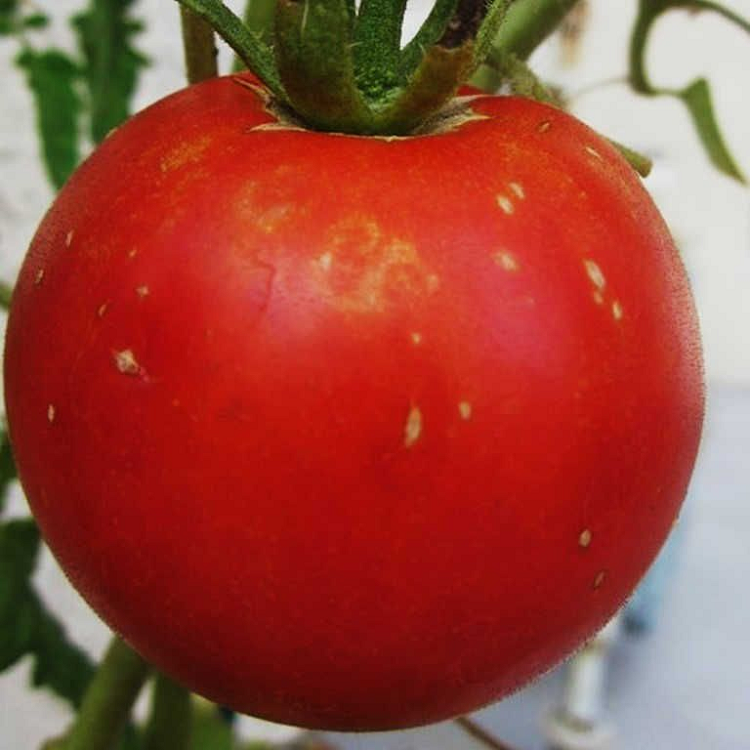
The different parts of the tomato plant attract various white spot-causing bacteria, mold, fungi, and insects. Let’s consider each cause and how to best manage the white spots. Before I get into the details, I’ve compiled a table if you are in a hurry. I also included information on whether you can safely eat the tomato depending on what causes the white spots.
| Reason for White Spots | Where on the Tomato Plant Can You See White Spots? | Treatment or Cure | Are the Tomato Fruits Still Edible? |
| Leaf Mold | Leaves (commonly)
Fruit and flowers (in severe cases) |
Remove affected leaves and any plant debris
Treat with a fungicide (organic or chemical) |
Yes, if spots are only found on the leaves and treated early |
| Powdery Mildew | Leaves and stem (commonly)
Fruit (in severe cases) |
Remove affected leaves
Treat with sulfur dust, neem oil, bicarbonate solution, or bio-fungicide |
Yes, provided the fungi hasn’t infected the fruit |
| Pests
> Stink bugs > Aphids > Psyllids > Whiteflies > Spider mites |
Leaves
Fruit |
Hose the plant
Handpick larger bugs Apply insecticidal soap, or spray with neem oil, mineral oil, or an insecticide Use natural predators |
Yes, and you can opt to cut away the white, tough spots and eat the rest of the tomato |
| Sunscald | Leaves
Fruit |
No treatment
Remove damaged fruit Provide shade for any unaffected tomato fruit |
Yes, unless the fruit has been infected with black mold |
| Nutrient Deficiency | Leaves
The whole plant (if severe) |
Identify which nutrient is deficient
Use an appropriate fertilizer to correct the nutrient deficiency |
Yes |
| Bacterial Canker | Fruit
Leaves Stems |
No treatment
Remove infected tomato plants and neighboring plants ASAP Sterilize the soil and garden tools Practice crop rotation |
Yes |
| Septoria Leaf Spot | Leaves
Stems Petioles |
Remove affected leaves and properly dispose of them
Apply a fungicide or sulfur dust to protect new leaves |
Yes |
Causes of White Spots on Tomato Plants

I’ve learned there are various causes of white spots on tomato leaves, stems, flowers, and fruit. It is sometimes challenging to diagnose the cause of the white spots because the symptoms of some diseases are very similar, or a range of symptoms develop over time. Prevention is always better than cure or treatment, so I recommend taking note of the white spot prevention tips I share.
Here are the most common causes of white spots on tomato plants:
Leaf Mold
Location of the white spots: leaves
Leaf mold usually affects tomatoes that are grown in greenhouses and high tunnels. However, it can also be found in the field – and your veggie garden!
It’s a common fungal disease caused by a fungus called Passalora fulva. The fungal pathogen spores rapidly increase when the temperature and humidity are high (85% or higher), and there isn’t sufficient airflow between the plants. The spores easily spread via air, rain, wind, infected garden tools, and insect activity to infect the nearby tomato plants.
Leaf mold indirectly affects crop yield, but in severe cases, the spores can also infect the tomato plant blossoms and fruit. If the fruit is infected, the tomatoes will be dark and leathery. You’ll also see rot at the end of the stem.
How to Identify Leaf Mold
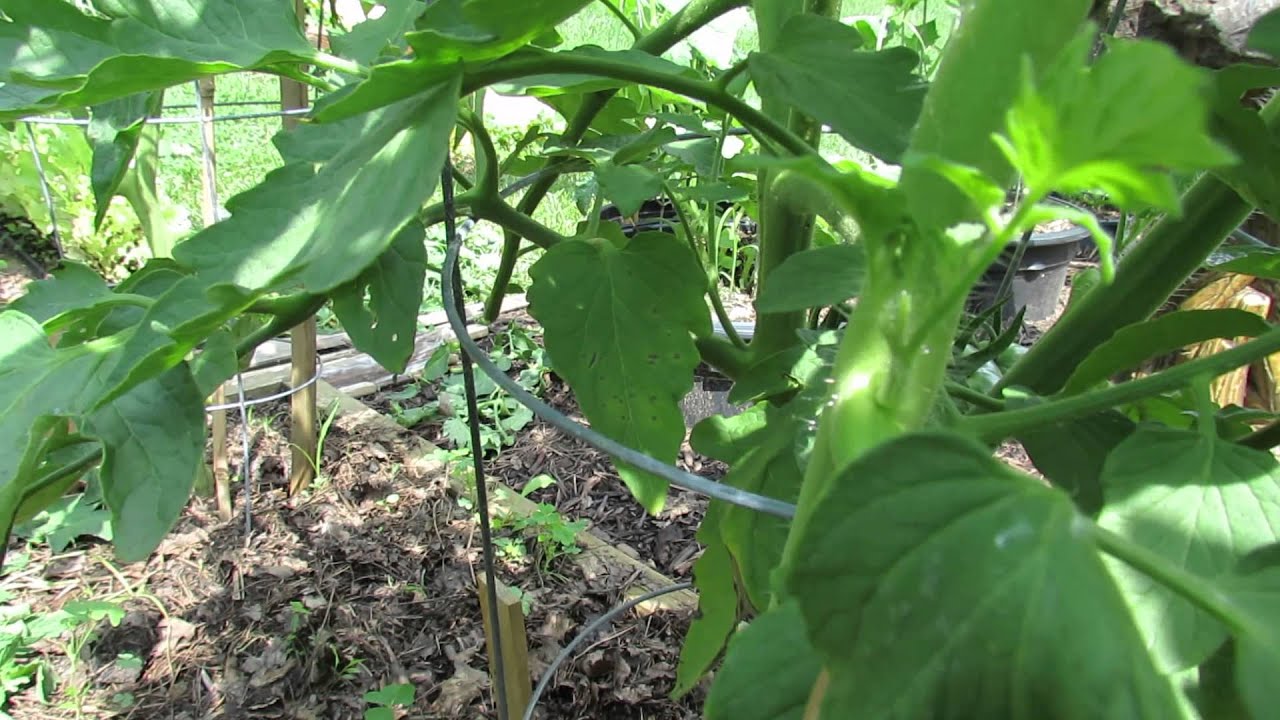
When I check whether leaf mold is the cause of the white spots, I look at the bottom leaves of the tomato plant that are closest to the soil. These are the oldest leaves, and leaf mold infects these leaves first. The upper areas of the old leaves will have white spots, and as the leaf mold spreads, the white spots grow and turn yellow.
When humidity levels are high, a gray fungal growth that looks fuzzy covers the underside of the tomato plant leaves. As the infection becomes more severe, all the white spots coalesce (come together to form one big spot). Eventually, the leaves wilt and die.
How to Treat Leaf Mold
- Prune the infected leaves
- Remove plant debris around the plant, like dead leaves
- Apply a chemical fungicidal spray like a calcium chloride spray, an organic fungicide, or a natural remedy like a vinegar and apple cider solution to reduce the spread of the fungal spores; spray the whole tomato plant, especially the leaf undersides
- Remove severely infected tomato plants that are beyond saving
How to Prevent Leaf Mold
- Improve the air circulation between the tomato plants by planting them further apart and pruning
- If you grow the tomatoes in a greenhouse or high tunnel, reduce the humidity (below 85%)
- Use drip irrigation or soak watering methods to prevent the leaves from getting wet while watering
- Water the tomato plants in the early morning hours so the plant can dry before the sun comes up; this helps lower humidity
- Use a preventative fungicide program with copper-infused fungicide, mancozeb, and chlorothalonil
- Buy leaf mold-resistant tomato cultivars like Red Mountain, Primo Red, Geronimo, Boa, Trust, Cherokee Purple, and Prudens Purple
- Ensure you buy tomato seeds from reputable sources
- Practice crop rotation where you don’t plant tomatoes in the same spot for two consecutive seasons; alternate with cole, leafy greens, beans, peas, and sweet corn
Powdery Mildew
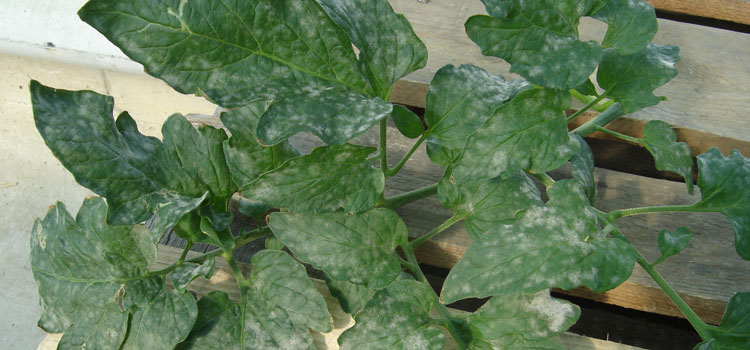
Location of the white spots: leaves, stems, and fruit
Powdery mildew is caused by various fungi like Erysiphe lycopersici, Oidium lycopersicum, or Leveillula taurica. The fungi love warm and humid environments with little to no airflow and lots of shade. You’ll find powdery mildew on your tomato plants during spring and summer.
The pathogen spreads by wind and can also stay in the soil.
How to Identify Powdery Mildew
When examining my tomato plants for powdery mildew, I’ll see fuzzy and moldy white spots on the undersides of the leaves. The first signs of powdery mildew appear on the bottom leaves, and then the fungi spores spread to the leaf upperside, the stem, other leaves, and nearby plants.
Young leaves with powdery mildew white spots will also:
- Turn yellow
- Start curling
- Dry out
- Be disfigured
If it’s a case of severe powdery mildew, I know my tomato fruits will be affected – the fungi spores prevent the tomatoes from absorbing sunlight, stunting their growth.
How to Treat Powdery Mildew
- Prune all infected leaves
- Remove tomato plants that are severely infected and properly dispose of them so the fungi spores don’t infect other plants
- Apply a bio-fungicide, neem oil, bicarbonate spray (1 teaspoon of sodium bicarbonate or baking soda and 1 drop of liquid dish soap in 2 gallons of water), or wettable sulfur fungicide (1.5-3 teaspoons of sulfur dust with 2 gallons of water) to the plant every week until there are no more white spots
How to Prevent Powdery Mildew
- Mulch the tomato plants to keep soil-borne diseases and pathogens from infecting the lower leaves
- Ensure you don’t splash water on the leaves when watering your tomato plants; use a drip irrigation system
- Use preventative fungicides when planting
- Ensure good airflow between tomato plants by planting them 18-24 inches apart and pruning when necessary
- Ensure the plants get sufficient sunlight (6-8 hours per day)
- Plant tomato cultivars like Geronimo, Masada, Panzer, and Imperial 643 that are more resistant to fungal infections
Pest Activity
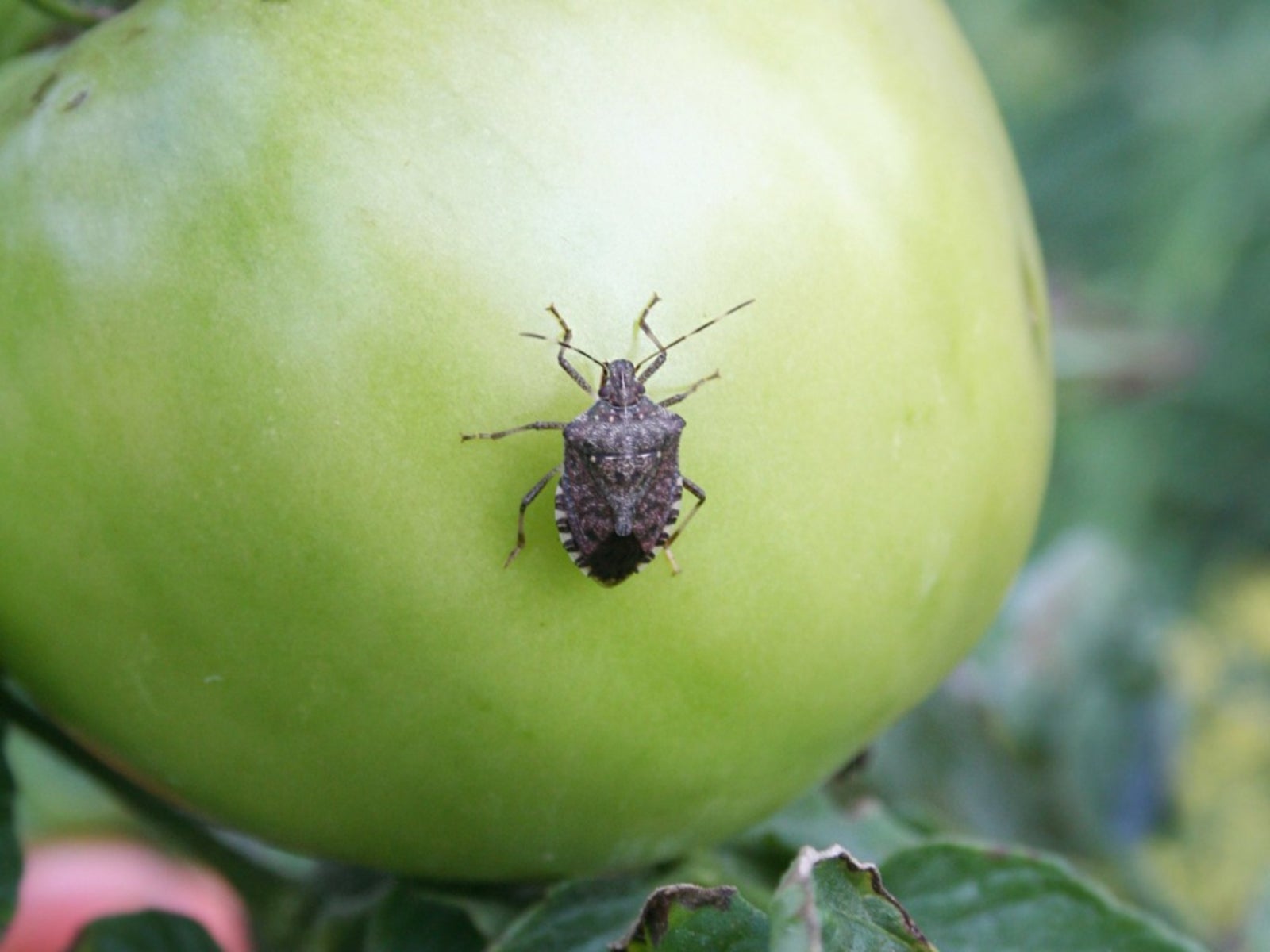
Location of the white spots: tomato fruit and/or leaves
Various pests cause white spots on your tomato plants.
Stink Bugs
Stink bugs are the most common pest on tomato plants. The bugs suck the juice out of the tomato fruit via their needle-like mouths. They leave white or yellowish spots on the tomato skin when they are done.
Aphids
Aphids are sap-sucking insects that feed on the sap found in the tomato leaves. Aphids aren’t white, but they shed their skins as they feed and grow. The white skin castings (which look like sprinkles of white) are left on the leaves.
Psyllids
Like aphids, psyllids also feed on the cell sap of tomato leaves. These plant lice excrete white waste on the leaf surface, and the waste looks like grains of white sugar.
Whiteflies
When there are lots and lots of whiteflies on the underside of the tomato leaves, you’ll see white spots. Otherwise, these tiny insects are pretty much invisible.
Spider Mites
When spider mites have infected tomato plant leaves, the moldy white spots are actually their webs. These insects also feed on the leaves, leaving behind bleached or mottled spots.
How to Identify Pests

If I suspect that stink bugs are responsible for the white spots on my tomatoes, I look for the telltale white or yellowish marks on the outside of the tomato. Stink bugs also leave yeast infections or toxins on the tomato skin, and these areas turn white, fibrous, and tough. The rest of the unaffected tomatoes will continue to grow as expected.
If aphids, spider mites, psyllids, or whiteflies have made my tomato plant leaves their home, I’ll see white spots in the shape of sprinkles, sugar grains, blotches, or webs.
There will also be other telltale signs to identify which pest is responsible for the damage:
- Aphids – leaves will yellow and ooze honeydew (sticky white residue)
- Psyllids – leaf veins will turn purple
- Whiteflies – honeydew oozes
How to Treat Pests
- Hose your tomato plants with a strong stream of water to dislodge the pests; hose daily for a week
- Use gloves to handpick the insects like stink bugs; place the pests in a container filled with soapy water to drown them
- Apply an insecticidal soap (one that’s organic!) to remove aphids, psyllids, and spider mites
- Spray the plant with neem oil or a mineral oil-water solution to block the air holes of the pest, which will inhibit growth and disrupt feeding
- Dust tomato leaves with sulfur to get rid of psyllids
- If the pests don’t want to die, use a chemical insecticide and treat the plant for 2-4 weeks according to the instructions on the label
- Attract and use natural predators like ladybugs, whitefly parasites, and lacewings
How to Prevent Pests
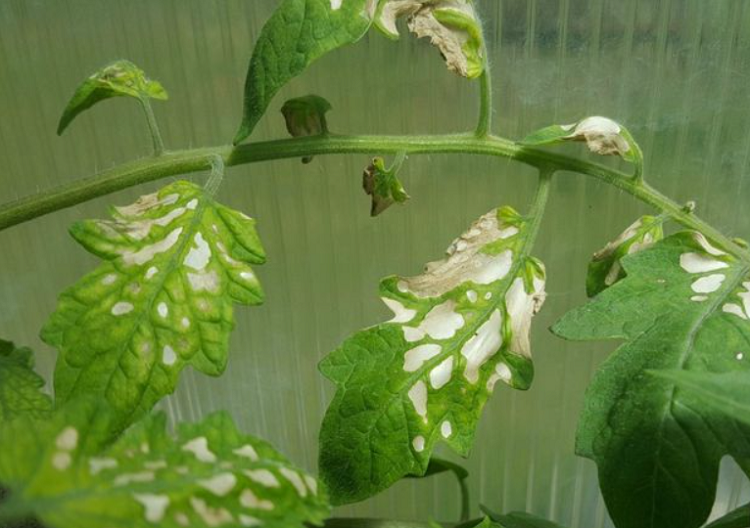
- Introduce predatory insects like ladybugs, syrphidae species, spiders, and lacewings to eat tomato plant pests and plant herbs that are attractive to these predators to protect your tomato plants
- Plant trap crops like buckwheat, millet, sunflowers, marigolds, lavender, chrysanthemums, and garlic to entice pests to feed on these instead of your tomatoes
- Attract swifts and other insect-eating birds
- Spray your tomato plants with diluted soapy water (1-2 tablespoons of mild dish soap in 1 gallon of water) weekly and after the rain
Sunscald
Location of the white spots: tomato fruits and/or leaves
I’ve learned that tomatoes are sun-loving plants, but like all things in life, too much sun isn’t ideal. In fact, excessive sun exposure leads to white spots on the tomato fruit and/or leaves. This condition is called sunscald, or where the leaves are “burned,” leaf burn, or sunburn.
How to Identify Sunscald
When my tomatoes had sunscald, I knew this was the cause because apart from the white blotches or blisters on the fruit skin, the tomatoes also became sunken. Eventually, the sunken area rots, or bacteria, fungi, or pests can take advantage of the softer, vulnerable sections.
Black mold can also take root in the sunscalded areas, which will affect the taste of the tomato.
The hot sun can also burn the tomato leaves, resulting in yellowish or white patches forming on the leaf surface. The leaves eventually dry out and curl, turn brown, and fall off, inhibiting the tomato plant’s growth and overall health.
How to Treat Sunscald
- Sunscald isn’t a disease, so there’s no treatment. Or rather, the only treatment is prevention
- Remove any damaged fruit
- Provide shade to any unaffected fruit that’s still growing
How to Prevent Sunscald
- Ensure tomato plants get their 6-8 hours a day of full sun exposure, but on extra hot days in the summer or during a heatwave, cover them with shade cloth
- Since sunscald is common in transplanted seedlings, harden off the tomato plants by gradually exposing them to more sun every day over 7-10 days
- Don’t excessively prune the tomato plant to ensure there’s sufficient foliage and shade for the tomato fruits
- Plant tomato varieties that have heavy foliage
Nutrient Deficiencies

Location of the white spots: leaves
A nutrient deficiency is another cause of white spots on tomato plant leaves.
How to Identify Nutrient Deficiencies
You’ll know which mineral the tomato plant is deficient in based on what the leaves look like. Generally, all nutrient deficiencies start out as white spots on the tomato leaves.
- Nitrogen deficiency – the whole plant will yellow, including new and old leaves
- Phosphorus deficiency – bright yellow edges on mostly older leaves
- Magnesium or potassium deficiency – the leaf surface will yellow between the green veins; the surface becomes uneven
- Calcium deficiency – distorted leaves and blossom end rot
The tomato plant is nitrogen or phosphorus deficient if the leaves have developed white or yellowish spots. Eventually, the whole leaf will whiten or yellow.
If there are white spots on the leaves, but the veins are still green, you are dealing with a magnesium or calcium deficiency.
How to Treat Nutrient Deficiencies
How you treat a nutrient deficiency depends on what mineral is lacking. I recommend using the following:
- Nitrogen – Add well-rotted organic matter to the soil and mulch the plant; use liquid tomato fertilizer or bat guano fertilizer
- Magnesium – Use dolomite limestone or spray tomato leaves with 4.5 teaspoons of Epsom salts and 1-2 drops of liquid soap in 34 ounces of water every other week
- Phosphorus – Use alfalfa meal
- Potassium – Add organic matter to the soil and mulch the plant. Also, add liquid tomato plant fertilizer, sulfate of potash, kelp, or a blood, fish, and bone fertilizer
- Calcium – Use garden lime
How to Prevent Nutrient Deficiencies
- Fertilize tomato plants after they’ve been planted and before they begin fruiting
- Test the soil to ensure it is nutrient-rich, and if it isn’t, fertilize the soil a month before planting tomatoes
Bacterial Canker
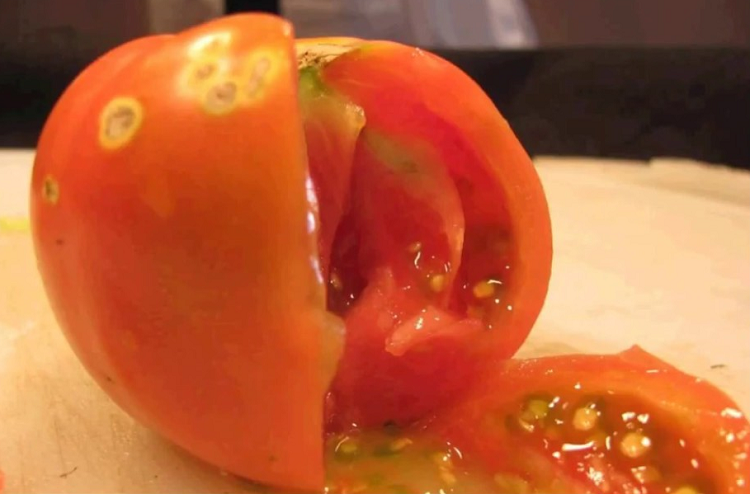
Location of the white spots: fruit, leaves, and stems
Bacterial canker is a bacterial disease caused by Clavibacter michiganensis. This is a severe disease that, if left untreated, can wipe out your entire nightshade vegetable garden. The bacteria spread easily via plant to plant contact, wind, infected garden tools, and water splashing.
How to Identify Bacterial Canker
Bacterial canker causes various symptoms on your tomato plants:
- Leaflets wilt
- Older leafs dry, curl, and eventually wilt
- Stems develop light-colored streaks, which break open, forming cankers with yellow bacterial ooze
- Small, snowy white spots with tan-colored raised centers appear on tomato fruit
- A white halo is visible around the white spots
How to Treat Bacterial Canker
There is no known treatment for tomato plants infected with bacterial canker since it’s highly infectious and not easy to identify because of the wide range of symptoms.
If your tomatoes have bacterial canker, remove the plants and neighboring ones and safely dispose of them (in a garbage bag or burn them). Then, sterilize any garden tools you used and the soil and thoroughly wash your hands.
How to Prevent Bacterial Canker
- Don’t water your tomato plants from above; use drip irrigation
- Sanitize all garden tools and plant supports
- Infected seeds are usually the culprit for bacterial canker, so buy disease-free treated tomato plant seeds from reputable sources
- Regularly weed plant beds since bacterial canker pathogens live on weeds
- Practice crop rotation
Septoria Leaf Spot
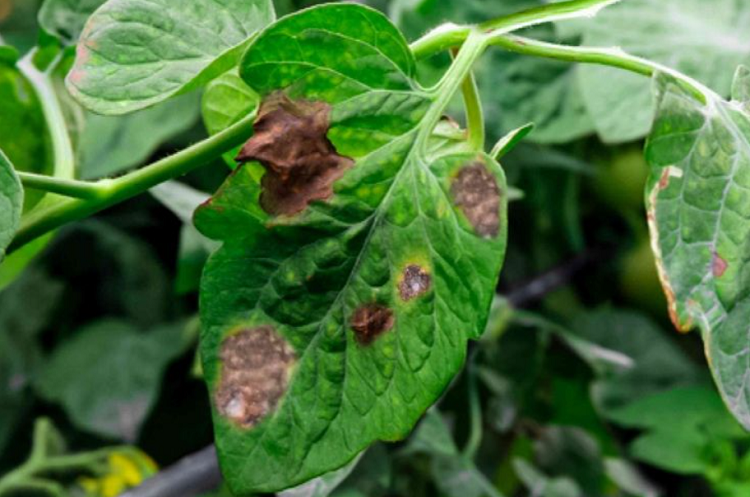
Location of the white spots: stems, petioles, and leaves
Septoria leaf spot on tomato plants is caused by a fungus called Septoria lycopersici. The fungi are primarily active in high temperatures and humidity and when the leaves are wet because of rainfall or watering.
How to Identify Septoria Leaf Spot
If you see white spots on your tomato plants, it could be Septoria leaf spot if there are small circles with light gray or white centers and darker edges on the leaves, stems, or petioles. Tiny black dots may be visible in each whitish spot.
Septoria leaf spot first affects the bottom, older leaves before the fungi spores spread. Leaves infected with the Septoria fungus will yellow, wilt, and fall off.
How to Treat Septoria Leaf Spot
- Remove affected leaves and stems
- Repeatedly apply copper or chlorothalonil fungicide or mancozeb to keep the disease in check
- Dispose of these in a trash bag or burn the leaves and stems
- Sulfur dust new leaves to protect them
How to Prevent Septoria Leaf Spot
- Use drip irrigation or other watering methods, so the plant leaves don’t get wet
- Fungi can overwinter, so practice crop rotation of 3 years and remove crop debris
- Sanitize the soil if tomato plants have been infected with Septoria leaf spot
- Ensure proper air circulation between tomato plants by regularly pruning the leaves and planting the tomatoes 18-24 inches apart.
FAQs
Answer: There are various causes of white spots on tomatoes:
• Bacterial infections like bacterial canker
• Fungal diseases like leaf mold and powdery mildew
• Environmental factors like nutrient-deficient soil or too much sun and heat
• Pest invasions from stink bugs, aphids, psyllids, whiteflies, and spider mites
Answer: Generally, it is safe to eat tomatoes with white spots. Discard any tomatoes with a moldy growth, as the mold spores have likely infected the whole tomato fruit.
Answer: Tomato sunscald is the equivalent of sunburn on your tomato fruits and leaves. When the sun is too hot (think heatwave), the leaves of the tomato plant burn, forming white blotches.
The leaves eventually dry out and fall off. Sunscald also affects the tomato fruit, creating white spots or blisters that attract fungi, bacteria, black mold, and pests.
My Final Thoughts on Tomato Plants and White Spots
It’s horrible when you realize something is wrong with your vegetable crops. Finding white spots on your tomato leaves, fruit, or stems is no different. I’ve had several cases of white spots on my tomatoes, each caused by something different. I’ve learned to troubleshoot these causes by identifying what caused the white spots and then taking action.
But I’ve learned to implement all the prevention methods I can. And I’m proud to say I didn’t have any white spot issues on my tomato plants during the last growing season. Yay! Want to know what else could go wrong with your tomatoes and how to troubleshoot? Check out our guide on why tomato leaves curl.

